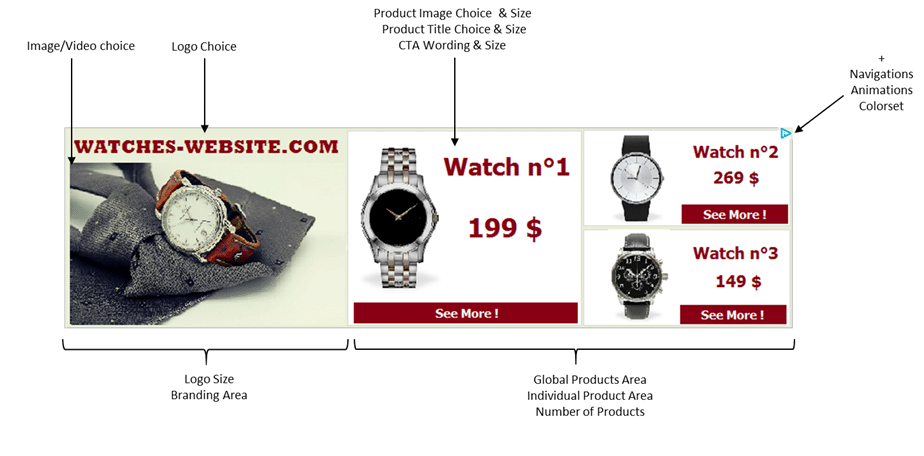Dynamic Creative Optimization – DCO
Most marketers know that personalization is the most powerful way for your ads to stand out, especially in the noisy digital world of today. If your ad isn’t customized to what a shopper wants at that moment, it’s essentially invisible.
That’s why Dynamic Creative Optimization has risen in the digital advertising industry over the last few years as a powerful way to improve the performance of display campaigns. With powerful machine learning technology at your fingertips, you can ensure that your ads continuously change according to each shopper’s preferences and browsing history.
What is DCO in advertising?
Dynamic Creative Optimization (DCO) is a digital advertising approach that tailors ad content — adjusting elements such as images, copy, sizing, number of products displayed, and calls to action in real-time based on user data. This personalized approach ensures that each viewer receives a tailored and relevant ad experience to maximize engagement and conversion rates. DCO enables advertisers to adapt their messaging dynamically, creating more effective and personalized campaigns.
How does DCO work?
Dynamic Creative Optimization operates by leveraging real-time data to customize ad content for individual users. It uses a variety of parameters such as user behavior, interests, and browsing history to alter creative elements that will resonate the most.
For example, imagine that a user who recently browsed running shoes might see a retail media ad featuring the exact pair they viewed, along with a personalized message emphasizing their interest. However, another user exploring hiking gear may encounter an onsite retail media ad showcasing relevant products based on their preferences, creating a more personalized and compelling advertising experience.
DCO advertising maximizes relevance and engagement, optimizing the likelihood of conversions. As users interact with content, DCO continues to adapt, ensuring that advertising messages remain aligned with the user’s evolving interests and behaviors.
In the future, as machine learning tools are fed with more data, there will be a broader spectrum of creative optimizations available.
Dynamic Creative vs. Dynamic Creative Optimization: Main differences
Let’s go over the concepts of Dynamic Creatives and Dynamic Creative Optimization, since the differences can be tricky:
- Dynamic Creative refers to the integration of graphical components in an ad’s creative using the shopper’s specific data: products seen, geolocation, time of display, etc. The graphical components are defined manually at the setup of a display campaign and the dynamic information is filled in real-time for each shopper before the creative is served.

Fig.1: Campaign with dynamic data (products and geolocation) and static graphical components and look and feel
- Dynamic Creative Optimization goes further. Rather than just filling a generic creative with personalized data, this technology uses machine learning to choose – in real-time for each shopper and context – the most relevant set of visual components to display, optimizing both the content and the creative.
The objective of such optimization is to improve the campaign’s performance; click-through-rate, conversion rate, sales, etc.

Fig.2: Campaign with dynamic data and dynamically optimized components (geolocation vs. ratings) and look and feel
Why is DCO important?
Dynamic Creative Optimization is valuable for advertisers due to the technology’s ability to quickly learn from each campaign and continuously modify elements for deeper personalization and optimal results. DCO marketing not only improves campaign performance — across acquisition, retention, and retargeting efforts — but also streamlines the setup process, handling data preparation, analysis, and delivery at scale without compromising brand guidelines.
Looking to the future, DCO advertising is still relatively in its early stages. Its ongoing development suggests it will become a pivotal component of the advertising industry. As DCO evolves, it will master more creative aspects, leading to a growing performance gap with non-optimized creatives. Emphasizing shopper focus, DCO ensures relevant marketing communication amid evolving industry challenges.
As DCO evolves, it is poised to play an even greater role in the advertising industry, mastering creative aspects and ensuring marketing communication remains relevant to users amid evolving industry challenges.

Fig.3: Ideas of dynamically-optimized parameters for a whole DCO creative.
Does Dynamic Creative Optimization use cookies?
Dynamic Creative Optimization can rely on first-party data rather than cookies to tailor ad content. First-party data is information collected directly from users through their interactions with a website or application. Unlike cookies, which are stored on a user’s browser, first-party data is obtained with the user’s explicit consent and is often considered more privacy-friendly.
In the absence of cookies, DCO advertising utilizes first-party data to understand user behavior, preferences, and interactions on a website. Advertisers collect and analyze this data to create user segments based on common characteristics. DCO then dynamically adjusts ad content in real-time, ensuring a personalized and relevant experience for each user segment. This approach respects user privacy while still enabling effective personalization, making first-party data a crucial component of DCO’s strategy for creating targeted and engaging advertising campaigns.
Dynamic Creative Optimization can also use contextual targeting, which analyzes the content of the webpage a user is currently viewing to determine the most relevant ad content. In this scenario, instead of relying on cookies, DCO adapts the creative elements based on the context of the page and doesn’t rely on specific user data.
Real-time Creative Optimization in the Criteo Engine
Criteo’s Dynamic Creative Optimization+ (DCO+) crafts personalized, real-time ads for every shopper. Driven by AI-powered optimization, it consistently delivers the most engaging ads tailored to meet specific marketing objectives. DCO+ not only accelerates time to market with responsive formats utilizing brand assets, but also ensures widespread visibility. By dynamically selecting design elements and products based on over 120 shopper intent signals, it significantly enhances shopper engagement, boasting up to 31% improvement in click-through rates. Additionally, DCO+ provides the flexibility to overcome size and layout constraints, enabling personalized designs optimized for various devices and display inventories at the opportune moment, ensuring maximum shopper reach and impactful results.
Curious about what DCO+ looks like in action? Explore actual ads from Criteo clients similar to your business in our Ad Gallery.










